Although I'm a lifelong bird lover, Paul and I aren't bird watchers in the classic sense of the word. I just like to watch them fly and listen to them sing. But since we've been living in Kenya we've both become avid birders. The birds are remarkable in their abundance and beauty and it seems that every trek into the countryside reveals a new species or two.
We've read there are more than 1,200 bird species in the country. Most are year around inhabitants but many migrate here to escape the harsh winters in the northern parts of the world. We've been quite amazed by the many varieties that can be spotted without leaving the clinic compound. Here are just a few of the birds we've seen in the past 6 months.

African Fish Eagle eating a hen in a tree behind our cook house. These huge predators are very common around Lake Victoria. A pair has built a nest at the top of the tree in front of the clinic and we hope to see some fledgling eaglets in the coming months.
 This tall and beautiful bird is a female saddle-billed stork which we saw in the grasses along the lake. It's an uncommon but spectacular bird that likes the wetland area around the lake and is about 5 feet in height.
This tall and beautiful bird is a female saddle-billed stork which we saw in the grasses along the lake. It's an uncommon but spectacular bird that likes the wetland area around the lake and is about 5 feet in height. This grey crowned crane is so exotic looking that you'd think you'd have to go to the Maasai Mara to see it but in fact, we found these birds within a few kilometers from our house. We often walk to the village of Aneko which sits on the lake and has a river encircling the other sides. So, with all that water it's a good area to see wetland loving birds like these.
This grey crowned crane is so exotic looking that you'd think you'd have to go to the Maasai Mara to see it but in fact, we found these birds within a few kilometers from our house. We often walk to the village of Aneko which sits on the lake and has a river encircling the other sides. So, with all that water it's a good area to see wetland loving birds like these. This little bird on the left is the African Paradise Flycatcher. They're very common in our area and can be seen most mornings hopping about in the mango tree or bougainvillea. His head looks black but is a very deep midnight blue.
This little bird on the left is the African Paradise Flycatcher. They're very common in our area and can be seen most mornings hopping about in the mango tree or bougainvillea. His head looks black but is a very deep midnight blue. This pretty green bird is the Madagascar bee-eater. I've only seen these birds twice in our compound, once while Paul and I were teaching a computer class in the cook house. I grabbed the camera and left him to carry on without me for a few minutes.
This pretty green bird is the Madagascar bee-eater. I've only seen these birds twice in our compound, once while Paul and I were teaching a computer class in the cook house. I grabbed the camera and left him to carry on without me for a few minutes.Here is the same bird in flight...
Although you can't see it clearly in this picture, the underside of their wings are a pretty ocher color.

The bird below is a speckled mousebird eating one of our guavas. Our cook Joice told us that when the mousebirds arrive the locals know the guavas are ready to eat.
Speckled mousebird in flight


I'll finish up with the kingfishers- first the black and white pied kingfisher on the left, below.Next to it on the right is the woodland kingfisher. It has beautiful vivid blue wings and an equally remarkable red and black beak. They're both very common along the lake shore.


And finally, my favorite bird thus far...the African pygmy kingfisher. We first saw this tiny bird on a walk in the countryside. It was one of the rare times that I didn't have my camera along and I was kicking myself the whole time for not getting a photo of it. Just a few days later Paul spotted this one sitting on our doorstep. He called me to get the camera and I was able to take at least a dozen shots. In fact, it sat there so long we began to suspect it was injured or a fledgling. But after we got a good look at it and it at us, it flew away. I suspect he knew how sad I was to have missed the shot the week before and came by to give me another chance at him.






























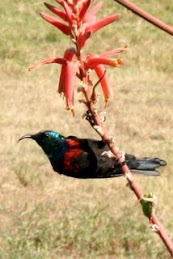
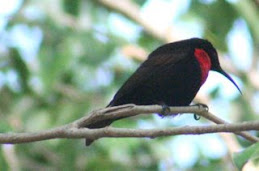










































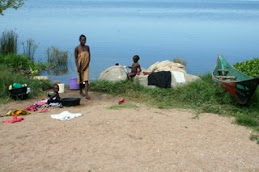

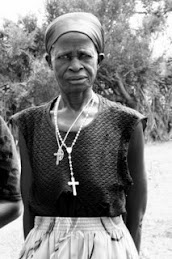






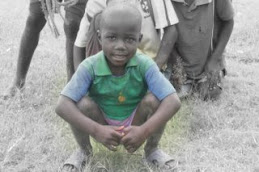


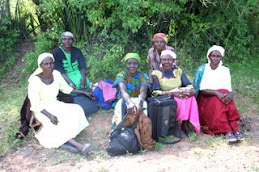



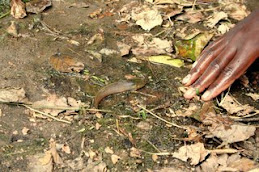



























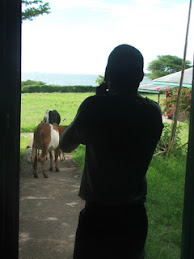















































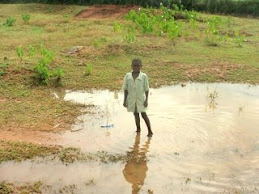
























1 comment:
Lovely post.. i usually watch documentaries on wildlife and nature and im really amused at the unique diversity found on the african continent.. lovely pictures..
Birth Certificate
Post a Comment